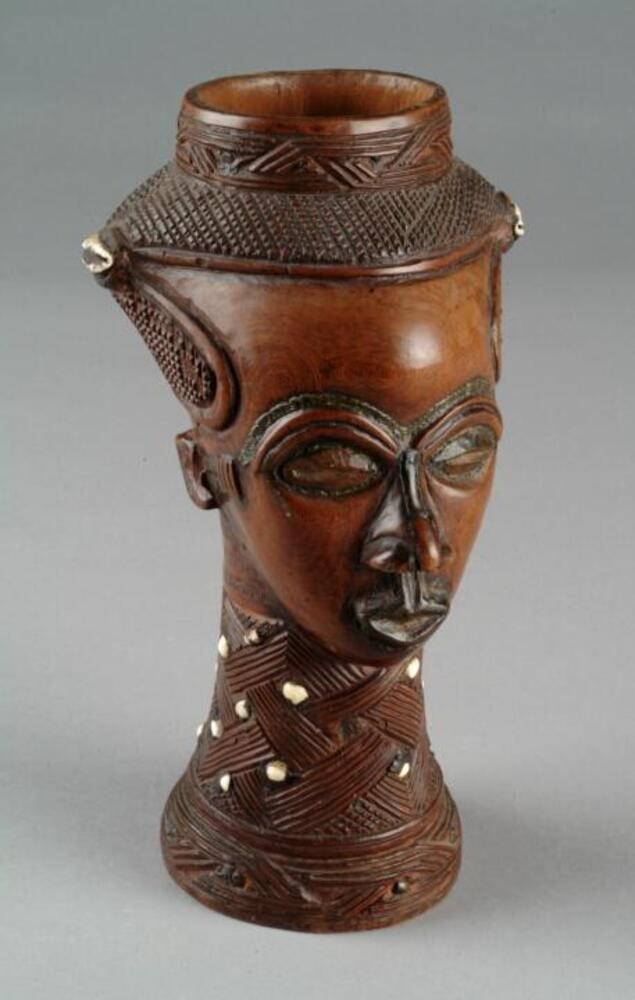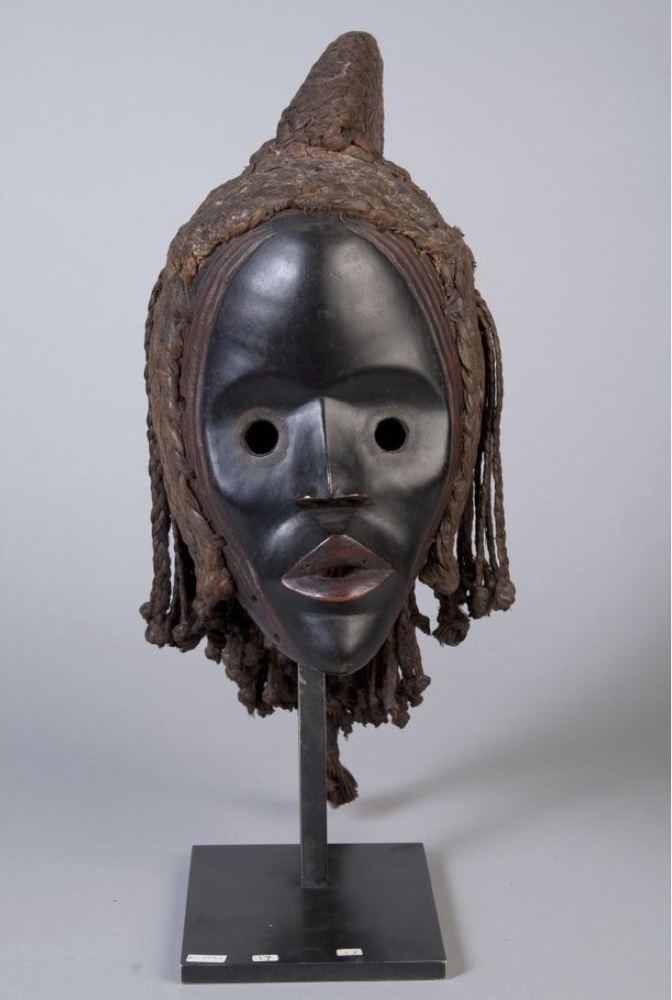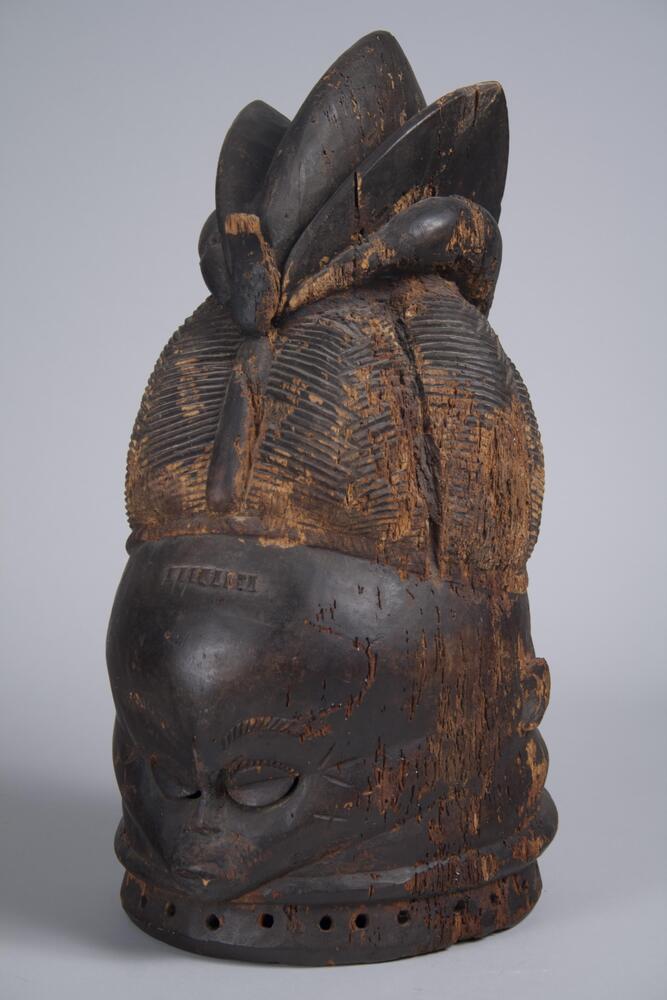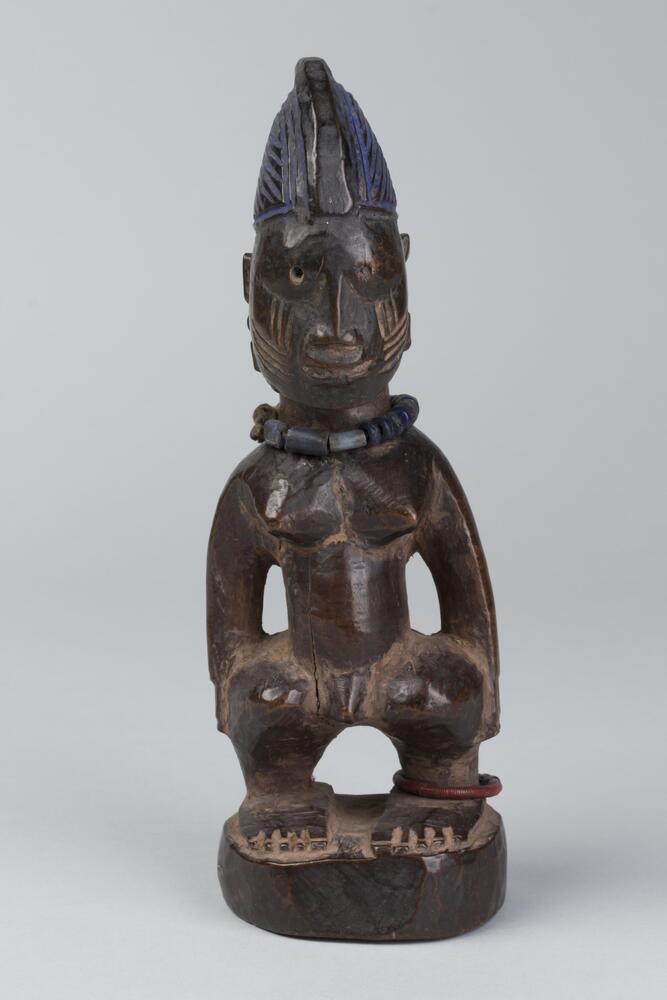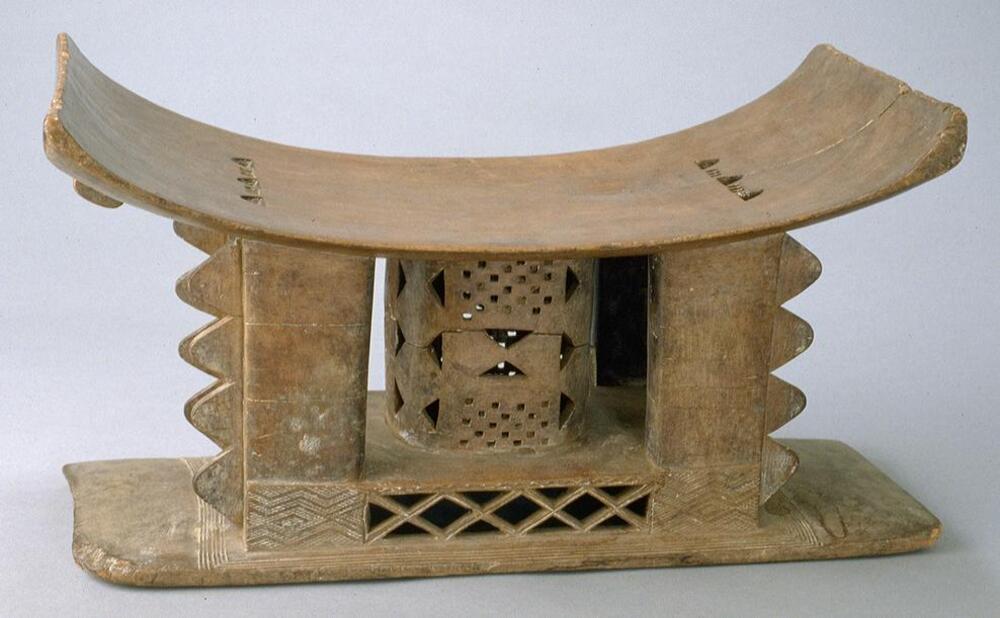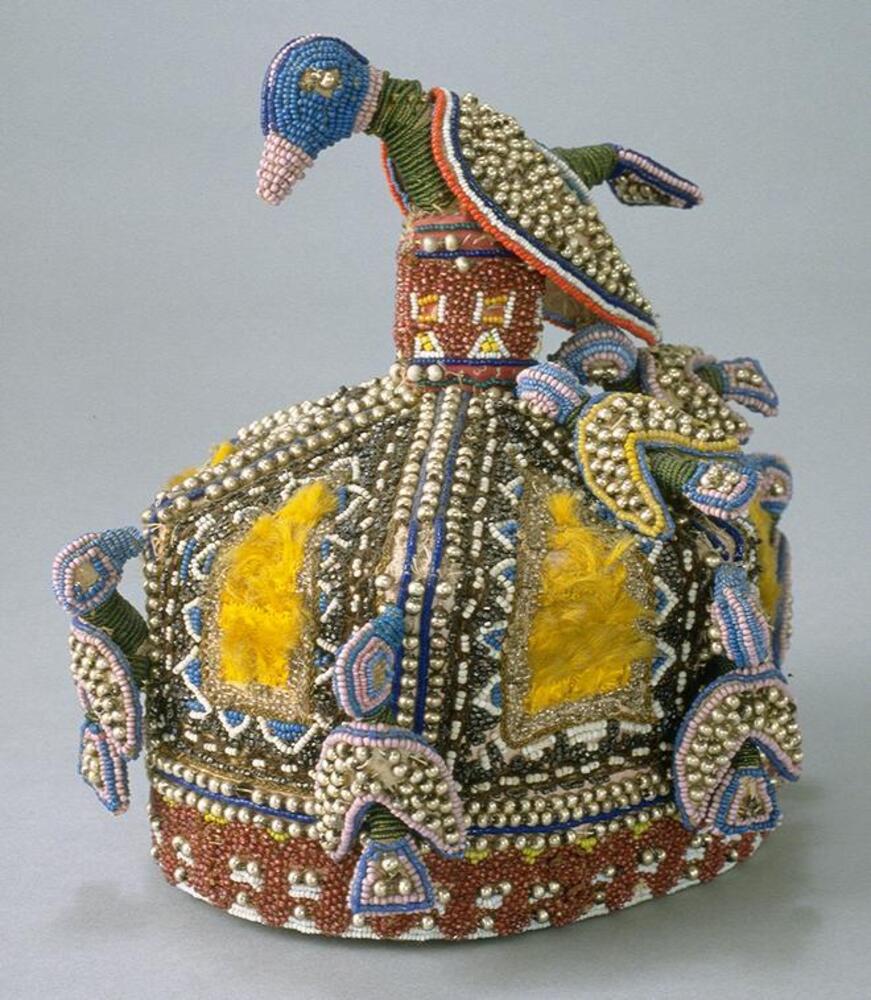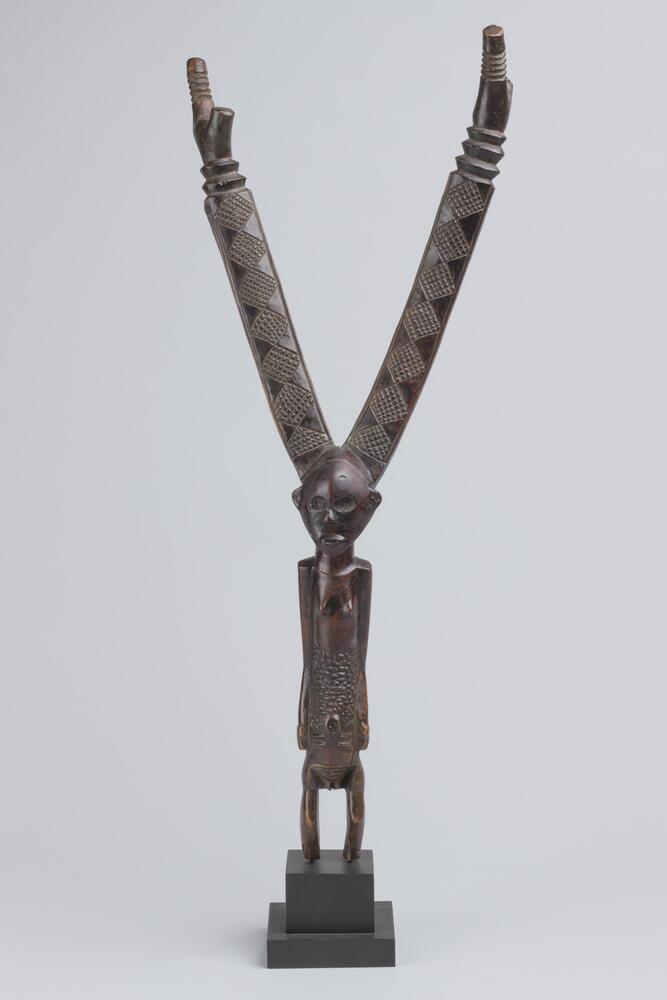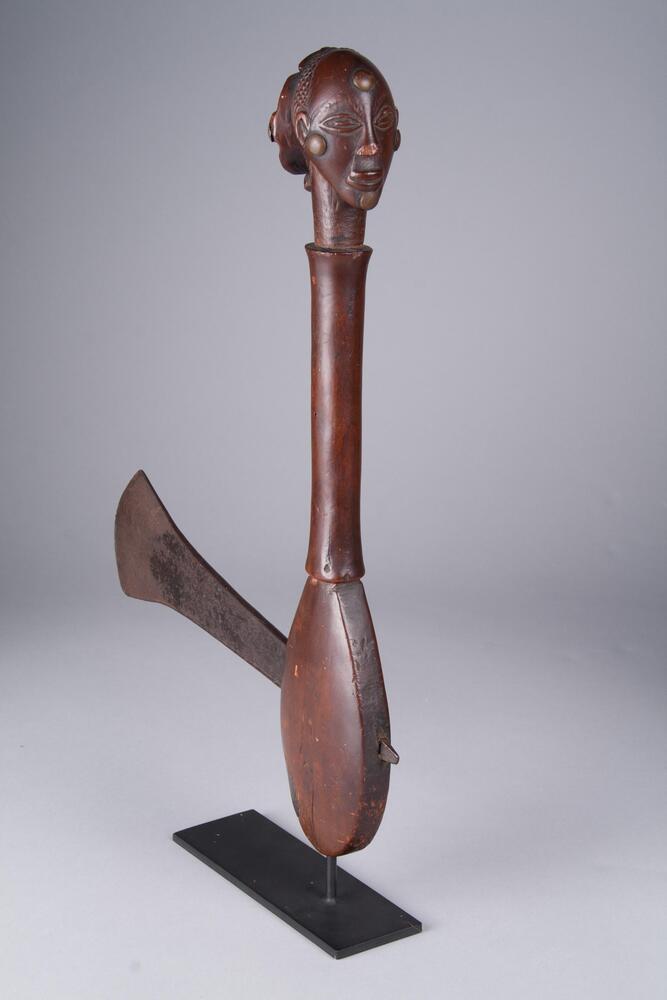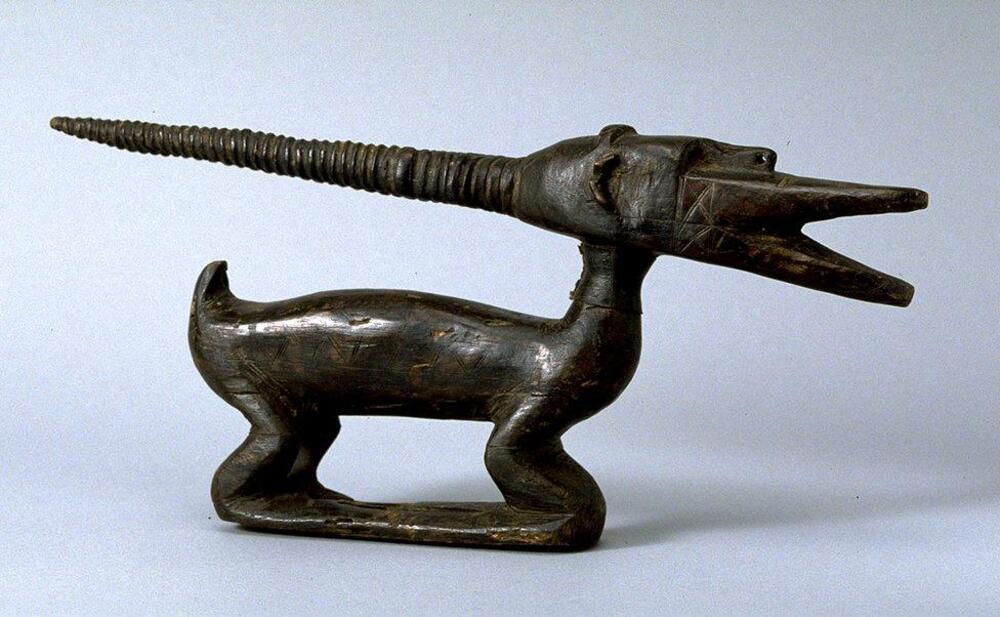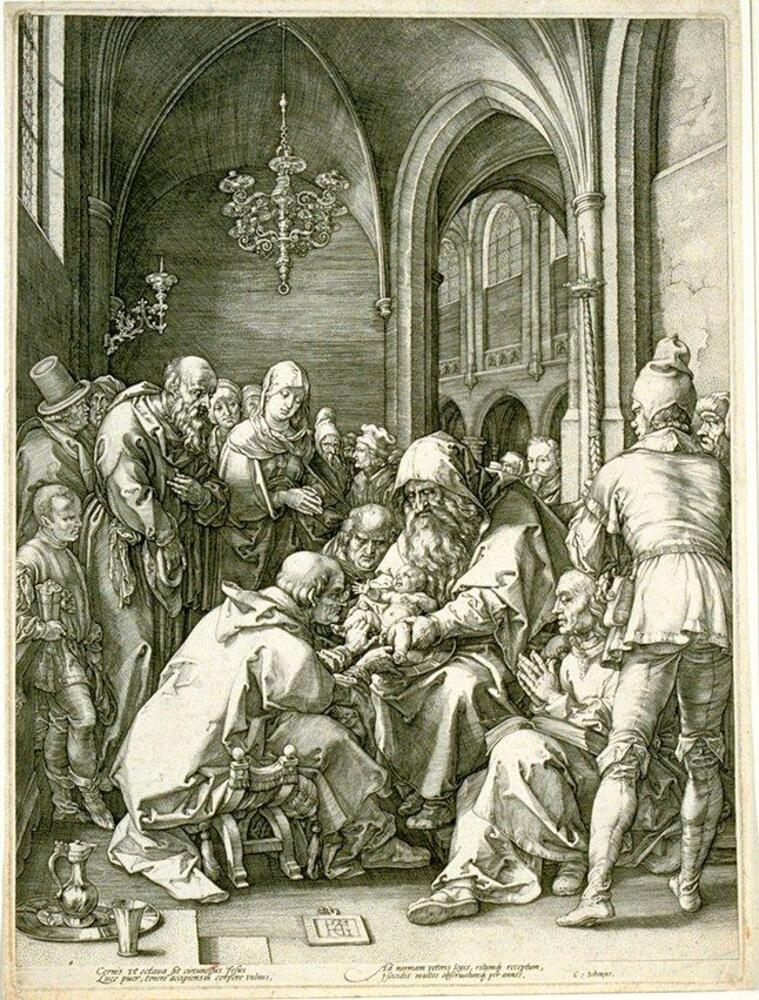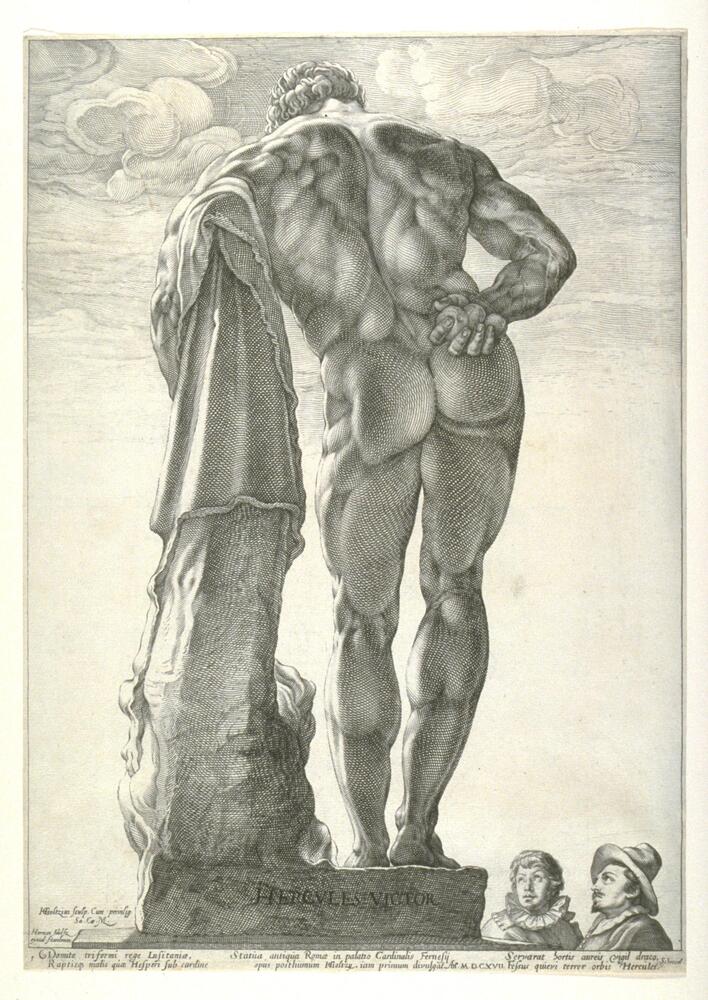PAST: Works selected for the course AAS 208 / HISTART 208Introduction to African Art: 100 African Objects
Instructors: Ray Silverman & Laura De Becker
This Study Case set features labels (below) written by students in enrolled in the course during the Winter 2017 term:
Label written by Adelia Davis:
This cup is from the Kuba culture of the Democratic Republic of the Congo, which is located in Central Africa. The Kuba kingdom is made up of many subethnicities. This piece comes from the Bushoong Kuba people. The levels of status in the Bushoong are identifiable in their art representations. Royalty and commoners were likely to have stools, makeup boxes, combs, hairpins, textiles, and eat and cooking implements. The quality of elaborate geometric designs and embellishments reflected the status of the individual.
The neck of this cup is detailed with sharp alternating engravings that are decorated with fragments of cowrie shells. Cowrie shells were at one point used as a form of currency, so embellishing this cup with cowrie shells represents wealth. Additionally, the hair style depicted on this cup is associated only with royalty. The practice of shaving the hairline to frame the forehead, is unique to the Kuba culture. This practice symbolizes wisdom and insight by drawing attention to the forehead, which represents a cultural belief that one’s spirit and individuality resides in the head.
Elaborate cups, like this one, were commissioned to be made by local artisans for royalty to serve palm wine to their court and friends. The popularity of this drink made wooden palm-wine cups an esteemed item in the nineteenth and twentieth centuries. Kuba royal society is important to acknowledge when challenging the primitive, single narrative of the continent of Africa that disregards the existence of many diverse and complex cultures.
Label written by Kayla Countryman:
The Dan Peoples carved this mask in the western part of the Ivory Coast (Cote d’Ivoire) near eastern Liberia, in the 20th century. The Dan Peoples are known for making small dark masks, which are sacred objects used in rituals and initiations. Many times, Dan Peoples’ masks are full body costumes that are used in dance and performance, but this particular mask sits on its own.
The mask’s full lips, curved and high-emphasized forehead, pointed chin, and slightly open mouth, all symbolize the Dan Peoples’ ideal standard of female beauty. Although the mask represents a woman, males wear the mask when they are initiated as adults into Dan society. Male performers, also called gle-zo, are said to experience a dream from the spirit of the mask that allows them to dance in it. When a performer wears the mask, he becomes the spirit of the mask itself.
Dan masks have been said to be the embodiment of at least a dozen personalities. Although it is uncertain, with its wide circular ocular apertures and red fibers, this mask may embody Gunyege, whose mask that is worn by a community's champion foot racers in competitions. Whichever form a Dan mask takes on, its main essence is ge, a supernatural being given to mankind to normalize relations between the living and the dead. Although this tradition embodies continuity with the past, the appearance of Dan masks has shifted overtime, showing the versatility of African art practices.
Label written by Xin Hu:
This mask was created by the Mende people in Sierra Leone. It is restricted for the senior leaders in the all-woman society, Sande. The Sande society plays an important role in the Mende villages for educating young Mende girls all the ritual knowledge and practical skills before marriage, during the Sande initiation. All the Sande initiation events segregate non-members. The primary function of this helmet mask was to make announcements to the community about the process of the initiation. Its other uses are performing in big events, such as a funeral or greeting special guests.
For the Mende people, the mask was a personification of the spirit. When the human figure wears the mask, she becomes a mediator between the earthly world and the spiritual world. The black and shiny surface of the mask not only represents her skin, but also mirrors the surface of the water, which is considered by the Mende people as the spiritual world. The mask’s design lies on the subtle balance between the aesthetic need to include personal identity and taste, and the practical need to be light and fixed when worn to dance. Common features include multiple rings on the neck, complex and large coiffures, and different scarification on forehead and cheek, which represent the owner’s well-being, high social status, and aesthetic taste.
The symbolic significance of the mask also lies on the social awareness of the Sande society, its independent education system, and the female status in the Mende people. The traditional way of acquisition was to be commissioned. However, under the influence of colonialism, the spiritual significance of the mask crumbled under the emerging supply-and-demand relationship.
Label written by Shannon Palmer:
The Yoruba peoples of mainly Nigeria, have the highest rate of twin births in the world. For this reason ere-ibeji figures, like the one displayed, draw on the spiritual connections between ase (“life force”) and the world of the living. The birth of twins is highly regarded in this society and viewed as a double blessing for families. This ere-ibeji figure would have been the match to a set of figures (both commissioned to be stylistically similar), which were so important that they often occupied small shrines in homes and were often carried as a child would carry a doll for play and amusement.
Standing erect with a rigid stance, the figure has its own presence and commands the respect regarded by members of the family. The figure is accentuated by scarification marks on the cheeks, a highly stylized coiffure, and beaded, colored jewelry which would have reflected the twin who was still living or had passed away. “African proportions” are evidence of the emphasis on parts of the body which connect closely with the ase and demonstrate continuities with the otherworld.
Although the Yoruba have the highest instances of twin births they also suffer the consequence of a very high infant mortality rate. It would have been a common sight to come upon a figure or figures such as this to honor and appease the soul of the deceased twin into adulthood.
Label written by Jordan Gottlieb:
This dwa, or stool, comes from the Asante Peoples of Central/Southern Ghana and Cote D'Ivoire in Western Africa. Literally translated, the word, dwa means 'carved from the wood'. For both practical and aesthetic reasons, this stool has been carved from a single block of wood from the osse tree. Over time, these stools darken in color, though it is believed that the lighter the color of an individual's stool, the purer of character is he or she. This particular dwa has not been adorned with any precious metals, which indicates that it belonged to someone of average social status.
In addition to their practical use as a place to rest, dwa provide crucial insight into the Asante belief system. When a dwa is not being used, it is generally placed on its side. Asante stools all follow the same general form, with a curved, crescent-shaped seat, and a rectangular base, connected by one large central column and four smaller ones. Each of these parts carry symbolic significance.
Asante peoples believe that the soul of a dwa's owner resides in the central column of his or her stool. Depending on its owner's status, a stool may be blackened upon his or her death. Typically, this ritual is reserved for those with some level of power, whether on the societal level or within a particular family. After a stool is blackened, it is used as a part of a shrine dedicated to a particular deity. Therefore, these stools not only fulfil a religious purpose, but also serve as a way to preserve history.
Label written by Jennifer Plascencia Lopez:
The beaded coronet is worn by the Yoruba ruler, the Oba, when he must make a public appearance and contact his ancestors to help bring prosperity to the Yoruba people. Beaded coronets very often have veils, iboju, attached to them. Yoruba people believe that disastrous events will occur to the one who makes direct eye contact with the Oba, so the veil serves to protect the people from his potent gaze. Furthermore, the Oba is believed to have great amounts of ase, a force that is only obtained by actively honoring ancestors, so the veil serves to contain his radiating power.
The beaded coronet combines the power of ancestors and the living world. Birds are often displayed on crowns to symbolize female ancestors, for they represent witchcraft and ability to nurture. The attachment of birds displays the king’s ability to contact these ancestors for good or great danger if needed.
The vibrant yellow feathers and the colorful glass beads symbolize the Oba’s wealth and power as these items are difficult to obtain. The earliest crowns made by the Yoruba people were decorated in only one color, but the introduction to trade allowed the importation of colorful glass beads from the Portuguese in the late 15th century. Moreover, beaded coronets have been worn by the Yoruba Obas for many years, yet crown designs appear to be more complex today; the increased means of transport to surrounding countries allow for the gathering of materials needed to build the crown, defying the belief that Africa is a continent in isolation.
Label written by Madison Brow:
This piece is an example of a nsakakabemba – a rest or stand for a hunting bow – and would be one of the most important ceremonial objects of the Luba and related peoples in the Democratic Republic of the Congo. This particular stand most likely belonged to a secondary chief within Luba royalty due to it being made out of wood, and would have been carved to mark his ascension into this important social role.
The bow rest stands as a symbol for the hunt, and more specifically refers to the ancient hero of the Luba peoples. This hero, Mbidi Kiluwe, was a renowned hunter and founder of the Luba kingdom whose most treasured possession was his hunting bow. In referring to Mbidi Kiluwe, the bow rest serves as a reminder to the bulopwe (or balopwe, meaning paramount chief) of the strength of this ancestor – an important figure in Luba’s cultural history. Unlike other chiefly symbols of power and prestige, the bow rest is kept from public view in the chief’s private rooms and is guarded by his kyabuta, a female guard who looks after and makes sacrifices to the nsakakabemba, and by extension Mbidi Kiluwe.
These artifacts have been mistakenly called port-flèches (arrow-carriers) by French scholars, reinforcing the mistaken impression of a violent and war-centric people. However, this is a purely ceremonial piece that acts as a reminder for the chief of the history and founding of his people.
Label written by Louis Hagopian:
This Hemba prestige adze – an ax-like tool usually used for shaping wood, digging, or tilling crop fields – is carved in a graceful and languid style that celebrates the beauty and power of femininity. Women were revered in Luba and Hemba society as mothers and priests and are often depicted in the art of both cultures. The female bust is modeled with naturalism and grace through its use of sweeping lines, coffee bean shaped eyes and delicate yet full lips. The hair is gathered in a traditional cruciform coiffure.
The prestige adze is one of the most important status symbols in Hemba and Luba society. The prestige adze acts as an insignia of rank and only the most powerful and/or significant members of society may wield one. This practice continues to this day in Central Africa.
The lips on this prestige adze are very typical of the traditional Luba style despite the rest of the adze being modeled in a style typical of Hemba production. The cruciform coiffure, elongated face, and oval eyes are all typical Hemba styles, while the large full lips are from the Luba tradition. The Hemba peoples adopted many of the Luba artistic traditions after the Luba attempted to incorporate the Hemba peoples into their growing empire in the 19th century. This sharing of styles between distinct cultures defeats the notion of “Africa as a country”, demonstrating the cultural diversity within regions.
Label written by Jackson Evans:
This Chi Wara headdress comes from the Bamana peoples of Mali, and was likely created in the early 19th century. The figure gets its name from Chi Wara, a mythical being that is believed by the Bamana peoples to have taught agriculture to man long ago. Like the divine being, the headdress is made of features that resemble the antelope, anteater, and crocodile. These animals symbolize the attributes most important to farmers, such as strength and the ability to harvest food from the earth.
Headdresses would have been worn in pairs by young male dancers in a celebration of Chi Wara as well as the farmers in the society. The pair would always be made of one male Chi Wara and one female. The juxtaposition of the male and the female would symbolize the duality between the strength and aggression of the sun (male), and the nurturing and fertility of the Earth (female), as a metaphor of the elements which dictate the success of an agricultural society.
Chi Wara headdresses became a symbol for what Europeans called “Primitive Art”, likely due to their abstract representation and a misunderstanding of the intended purpose of the figures. While these headdresses can be displayed as beautiful static carvings, the Chi Wara was initially created to be shown in a dynamic performance. Much of the importance of the Chi Wara lies in the cultural significance of agriculture to the Bamana people, and without this knowledge, the Chi Wara headdress cannot be fully appreciated.
Label written by DaRon Howard:
The Walu mask is an artifact belonging to the Dogon peoples in Mali. The word walu means antelope in Dogon. The mask is comprised of painted, carved wood depicting deep-set eyes that channel typical Dogon architecture: large, geometric shapes; sharp lines with rounded edges. The markings represent the stripes on an antelope’s fur. In the Dogon belief system, Walu had the responsibility of protecting the Sun from the Fox, or Yorugu. It was a responsibility bequeathed by the supreme God, Amma.
The mask is typically used for the dama —a final commemorative ceremony for an important Dogon elder. In these ceremonies, multiple members don the mask. The masks correspond to tiers of training with the elders that young men endure as they transition to manhood. In each ceremony, a performance is held in which the dancers scratch the ground with two short sticks. This action imitates the behavior of an antelope during its mating display. It also symbolizes a man, such as a farmer, hoeing a field. Both evoke reenactments related to Dogon beliefs on the creation of the world.
The Walu mask is typically preserved at sites of worship or at personal or family altars. It serves as a symbol of wisdom and can offer protection and a long life. This artifact confronts the notion that Africa is monolithic. Neighboring peoples within the Niger Delta region don varying masks each reflective of religious and socio-cultural ideologies. The Walu mask is merely one artifact from a panoply of cultural impressions in the continent.
Part of 1 Learning Collection
<p>In conjunction with the Ann Arbor District Libra...
<p>with Sophie Grillet, Docent</p>
<p>Winter 2018 Term</p>
<p>In celebration of March - Women's History Month<...
<p>Instructor: Lisa Makman </p>
<p><span style="font-size: 14px;">Instructors: Ray ...
<p>Instructor: Amrita Dhar</p><p><span style="font-...
<p>Instructor: Rebecca Zurier</p>
<p>Featuring object labels written by students in t...
Rate this Resource
AVG: 0 | Ratings: 0
& Author Notes
All Rights ReservedLast Updated
June 1, 2020 10:51 a.m.Report
Reporting Policy
